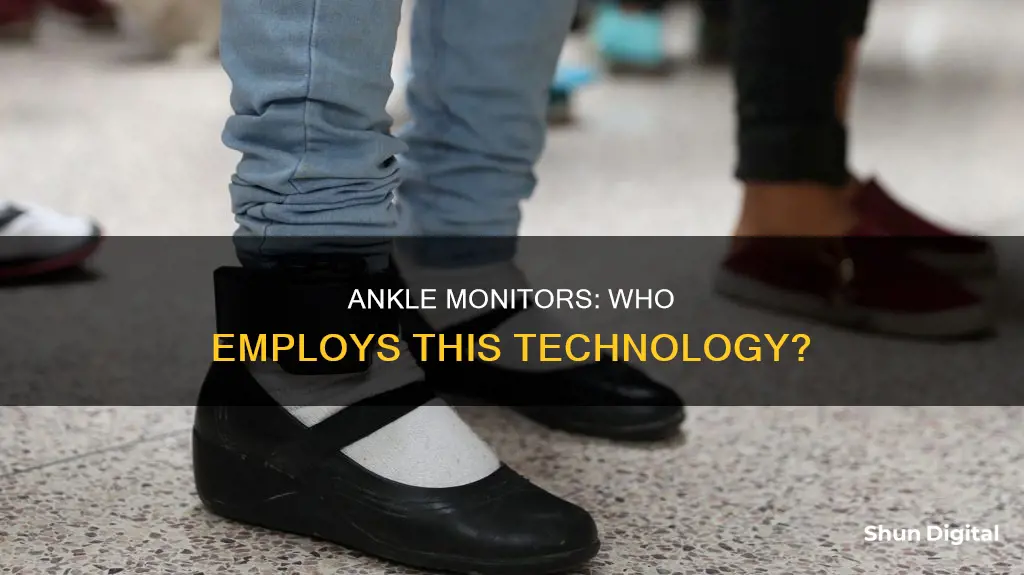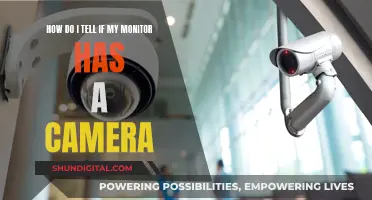
Ankle monitors are a form of electronic surveillance that tracks the location of wearers. They are typically strapped around the ankle and are used to monitor people awaiting trial, serving probation and parole, and facing immigration proceedings. The use of ankle monitors has been a growing trend, with a 140% increase in active monitors between 2005 and 2015. They are often seen as an alternative to incarceration, but critics argue that they contribute to mass incarceration and create barriers to re-entry for formerly incarcerated individuals.
| Characteristics | Values |
|---|---|
| Who employs ankle monitors | Courts, probation services, police, detention centres, private companies |
| Who wears ankle monitors | People awaiting trial, on bail, on probation or parole, facing immigration proceedings, or under house arrest |
| Reasons for wearing an ankle monitor | To ensure the wearer doesn't get into more trouble, is a flight risk, or is a danger to the community |
| Types of crime that may require an ankle monitor | Serious crimes (e.g. murder, sexual assault, major drug offences), repeat offending, domestic violence, DUI or DWI, immigration cases |
| How ankle monitors work | Electronic device fitted above the ankle that uses GPS or radio frequency technology to track the wearer's location |
| Features of ankle monitors | Alcohol monitoring, sweat sampling, zone storage, long battery life, strap design, user-friendly software |
What You'll Learn

Bail or probation conditions
Ankle monitors are sometimes used to allow individuals to remain free while awaiting trial, provided they meet certain conditions set by the court. These conditions can include sticking to a specific area, avoiding certain people, or adhering to a curfew. Ankle monitors are typically reserved for people awaiting trial who are considered a danger to the community or a flight risk.
Ankle monitors are also used as an alternative to jail sentences. For instance, if someone is convicted of a DUI, they may face jail time, including a fine. However, in some cases, judges may offer alternatives to a jail sentence, such as bail or probation. If the individual is deemed a low-risk offender, they may avoid jail by wearing an ankle monitor instead.
The use of ankle monitors can vary significantly based on jurisdiction, the severity of the crime, and the individual's previous criminal history. Some common situations where ankle monitors are used include:
- Serious Crimes: For more serious offenses like murder, sexual assault, or major drug offenses, courts often require the defendant to wear an ankle monitor as a condition of bail or parole.
- Repeat Offenders: Individuals with a history of reoffending or who have violated bail or parole terms in the past might be required to wear an ankle monitor to help prevent them from committing further offenses.
- Domestic Violence: In cases of domestic violence, ankle monitors can be used to ensure the offender maintains a required distance from the victim.
- DUI or DWI: Individuals convicted of multiple DUI or DWI offenses might be required to wear an ankle monitor that can detect alcohol levels, ensuring they comply with court orders not to drink.
- Immigration Cases: In some instances, individuals awaiting court dates for immigration proceedings may be required to wear ankle monitors.
Connecting a Monitor to Behringer Eurorack: Easy Steps
You may want to see also

Healthcare settings
Ankle monitors are used in healthcare settings, particularly in the tagging of elderly people and those with dementia. The same electronic monitors used to keep track of young offenders can be used for elderly people in care homes. For people with dementia, ankle monitors can be beneficial in preventing them from wandering away.
The use of ankle monitors in medical practice has generated controversy and media attention, particularly regarding the safety of patients and their privacy and human rights. At over 40%, there is a high prevalence of wandering among patients with dementia. Other methods to prevent wandering include constant surveillance, makeshift alarms, and the use of drugs that carry the risk of adverse effects.
The use of ankle monitors in healthcare settings is part of a broader debate about the use of electronic monitoring in society. Critics argue that this technology shares some of the information-gathering techniques found in maximum-security prisons, allowing them to diffuse into broader society.
Installing a New Monitor: Size Adaptation
You may want to see also

Immigration contexts
Electronic tagging or ankle monitoring is used in immigration contexts to track the location of migrants, asylum seekers, and immigrants. In the US, the Immigration and Customs Enforcement (ICE) agency uses ankle monitors as part of its Intensive Supervision Assistance Program (ISAP) to track people who would otherwise be incarcerated. This program is presented as an alternative to detention, but critics argue that it takes a physical and psychological toll on those who are monitored.
The ISAP program requires participants to be within 70 miles of their home and usually does not allow them to cross state lines. The ankle monitors are provided by BI Incorporated, a subsidiary of the private prison company GEO Group, which has had a contract with ICE since 2004. As of May 2021, there were 31,069 individuals wearing ankle monitors out of 96,574 enrolled in the ISAP program.
The use of ankle monitors on immigrants has been described as "traumatizing and abusive," with reports of physical and mental health issues, trouble sleeping, problems at work, and thoughts of suicide. The monitors can cause physical discomfort, such as cramps, numbness, and swelling, and some individuals have reported experiencing electric shocks. The constant surveillance and restriction of movement can lead to social isolation and difficulty finding and keeping a job.
In addition to ankle monitors, ICE has also implemented cellphone apps, such as SmartLINK, that use facial recognition and GPS to track the location of asylum seekers. This technology is seen as less cumbersome than ankle monitors, but it still raises concerns about privacy and the psychological impact of constant surveillance.
Powering Your ASUS Monitor: Wattage Requirements Explained
You may want to see also

Sex offenders
Ankle monitors are often used to track sex offenders in the United States. In some states, such as Georgia, the most dangerous sex offenders are required to wear an ankle monitor for life. This allows law enforcement to monitor their movements and ensure they are complying with the terms of their probation or parole. For example, in Georgia, "Level Three" offenders, considered "sexually dangerous predators", must wear an ankle monitor that alerts the local sheriff if the device is tampered with or the signal is lost.
The use of ankle monitors for sex offenders has been the subject of legal debate, with some arguing that it violates the Fourth Amendment right against unreasonable searches and seizures. In the case of Grady v. North Carolina, the U.S. Supreme Court held that monitoring a recidivist sex offender via an ankle bracelet device was indeed a "search" under the Fourth Amendment. The Court remanded the case to the state courts to determine whether the search was reasonable based on the totality of the circumstances.
The use of ankle monitors for sex offenders can also be costly for the wearer, with some individuals paying up to $30 per day for the device. This can lead to financial hardship and even homelessness, as individuals struggle to pay the fees while also dealing with the restrictions and social stigma associated with being a registered sex offender.
Proponents of ankle monitors for sex offenders argue that it helps to prevent recidivism and keeps the public safe. They believe that the benefits outweigh any potential violation of rights, especially considering the serious nature of sex crimes. However, critics argue that there is a lack of rigorous research to support the effectiveness of ankle monitors in reducing recidivism rates.
Freesync vs G-Sync: How to Identify Your Monitor's Tech
You may want to see also

Domestic violence
The use of ankle monitors in domestic violence cases serves multiple purposes. Firstly, they ensure that offenders comply with protection, restraining, and stay-away orders by alerting authorities if they venture too close to their victims. This technology helps create a safe space for victims, allowing them to remain in their homes and providing peace of mind, which can be particularly important during the separation phase when the risk of violence may escalate.
Secondly, ankle monitors can facilitate a shift in power dynamics by empowering victims to take legal action. The knowledge that their abuser is being monitored encourages victims to come forward and share their stories, potentially leading to more successful prosecutions. This proactive approach can help break the cycle of violence and reduce the number of homicides resulting from domestic abuse.
Additionally, ankle monitors can impose lifestyle restrictions on offenders, such as curfews or exclusion from specific locations, further reducing the likelihood of reoffending. The fear of consequences for breaching probation can act as a deterrent, encouraging offenders to modify their behaviour and seek reform.
The effectiveness of ankle monitors in addressing domestic violence has been demonstrated in various jurisdictions. For example, in Prince Edward Island, the Department of Justice and Public Safety adopted ankle monitors five years ago, and there have been very few issues reported with the program. Similarly, in Guilford County, North Carolina, a pilot program called "Caitlyn's Courage" has been credited with reducing domestic violence homicides to zero in the county.
While ankle monitors are a valuable tool in combating domestic violence, some concerns have been raised about the potential invasion of privacy for those who have not been convicted of a domestic violence crime but are nonetheless required to wear a monitor. Nevertheless, the benefits of enhanced victim safety and increased accountability for offenders generally outweigh these concerns.
Best Places to Buy Eizo Monitors
You may want to see also
Frequently asked questions
Ankle monitors are typically employed by law enforcement agencies, such as the police, probation services, or the court system. In some cases, private companies may also be involved in the installation and monitoring of ankle monitors.
The decision to require an individual to wear an ankle monitor is typically made by a judge or the court. This decision is often based on factors such as the perceived risk of the individual reoffending, their criminal history, and the severity of the crime committed.
Ankle monitors are typically required for individuals who are considered a danger to the community, a flight risk, or repeat offenders. They may also be used for those awaiting trial, serving probation or parole, or facing immigration proceedings.
Ankle monitors can provide an alternative to incarceration, allowing individuals to remain in the community while being monitored. This can help reduce prison populations and provide individuals with an opportunity to maintain connections with their families and communities. However, ankle monitors have also been criticised for contributing to mass incarceration, particularly for minor technical violations. They can also exacerbate systemic inequities, impact mental health, and lead to financial burdens for individuals and families.







